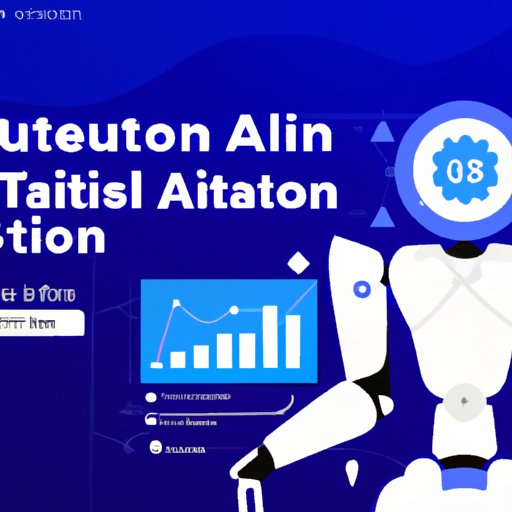Introduction
Artificial intelligence (AI) is quickly becoming an essential part of our lives. From self-driving cars to voice assistants, AI has the potential to revolutionize the way we work and live. But for many, getting started with AI can be intimidating. This article will provide a comprehensive guide to help you understand the basics of AI and how to get started using it.
AI is a broad term that encompasses a range of technologies, including machine learning, deep learning, natural language processing, computer vision, and more. All of these technologies are used to create intelligent systems that can learn from data and make decisions without human intervention. In this article, we’ll explore the basics of AI and how to get started using it.
Understand the Basics of Artificial Intelligence
Before you can start using AI, it’s important to understand what it is and what it can do. AI is a branch of computer science that focuses on creating machines that can think and act like humans. It involves creating algorithms that can learn from data and make decisions without human intervention. AI algorithms are able to recognize patterns in data and use that information to make predictions or decisions.
At its core, AI involves three components: data, algorithms, and hardware. Data is the input that AI algorithms use to learn and make predictions. Algorithms are the set of instructions that tell the AI system what to do. Finally, hardware is the physical infrastructure that runs the AI algorithms.
The most common types of AI algorithms are supervised learning, unsupervised learning, and reinforcement learning. Supervised learning algorithms are trained using labeled data, which means that the data has been labeled with the correct output. Unsupervised learning algorithms are trained using unlabeled data, which means that the output is not known beforehand. Reinforcement learning algorithms are trained using trial and error methods, where the AI system is rewarded or punished depending on its performance.
Identify Your AI Use Cases
Once you understand the basics of AI, the next step is to identify potential use cases. AI can be used to solve a wide range of problems, such as predicting customer churn, analyzing customer sentiment, optimizing supply chains, and more. To get started, it’s important to identify the problem you’re trying to solve and the data that will be needed to support each case.
For example, if you’re trying to predict customer churn, you’ll need to collect data on customer behavior, such as purchase history and website visits. If you’re trying to analyze customer sentiment, you’ll need to collect customer feedback data, such as survey responses and social media comments. Once you have identified the use cases and the data needed to support them, you can move on to the next step.

Analyze Your Data and Develop an AI Model
Once you have identified the use cases and the data needed to support them, the next step is to analyze the data and develop an AI model. This includes preparing and cleaning the data, selecting the right algorithm for your model, and training and testing the model. Preparing and cleaning the data involves removing any irrelevant or duplicate data and formatting the data so that it can be used by the AI algorithms.
When selecting the right algorithm for your model, it’s important to consider the type of data you have and the task you want to accomplish. For instance, if you have a large amount of structured data and you want to classify it, you may want to use a supervised learning algorithm such as a decision tree. If you have a large amount of unstructured data and you want to uncover patterns, you may want to use an unsupervised learning algorithm such as k-means clustering.
Once you have selected the algorithm, the next step is to train and test the model. Training the model involves providing it with the labeled data so that it can learn the patterns in the data. Testing the model involves providing it with new data to see how accurately it can make predictions. Once the model is trained and tested, it can be deployed to production.

Choose the Right AI Platform
Once the model is trained and tested, the next step is to choose an AI platform to deploy the model. There are a variety of AI platforms available, from cloud-based services to on-premise solutions. Each platform has its own pros and cons, so it’s important to evaluate your needs and choose the one that best meets your requirements.
Cloud-based AI platforms are popular because they are easy to set up and manage. They also offer scalability and flexibility, allowing you to quickly add or remove resources as needed. On-premise solutions are often more expensive, but they offer greater control over the environment and can be tailored to your specific needs.

Deploy Your AI Solution and Monitor Its Performance
Once you have chosen the AI platform, the next step is to deploy your AI solution. This involves setting up the environment, deploying the model, and configuring the platform. It’s also important to monitor the performance of the AI solution to ensure that it is performing as expected and making accurate predictions.
To monitor the performance of the AI solution, it’s important to track metrics such as accuracy, precision, recall, and F1 score. These metrics will allow you to assess how well the model is performing and identify areas where it needs improvement. Additionally, it’s important to keep an eye on the data that is being fed into the model to ensure that it is up-to-date and relevant.
Conclusion
In this article, we explored the basics of artificial intelligence and how to get started using it. We discussed the components of AI, the different types of algorithms, and the steps to developing an AI model. We also covered how to choose the right AI platform and how to deploy and monitor an AI solution. By following these steps, you can get started with AI and begin building intelligent systems.
If you would like to learn more, there are a number of excellent resources available. The book Hands-On Machine Learning with Scikit-Learn, Keras, and TensorFlow, 2nd Edition is a great place to start. Additionally, the website KDnuggets offers a wealth of information on AI and machine learning.
(Note: Is this article not meeting your expectations? Do you have knowledge or insights to share? Unlock new opportunities and expand your reach by joining our authors team. Click Registration to join us and share your expertise with our readers.)
